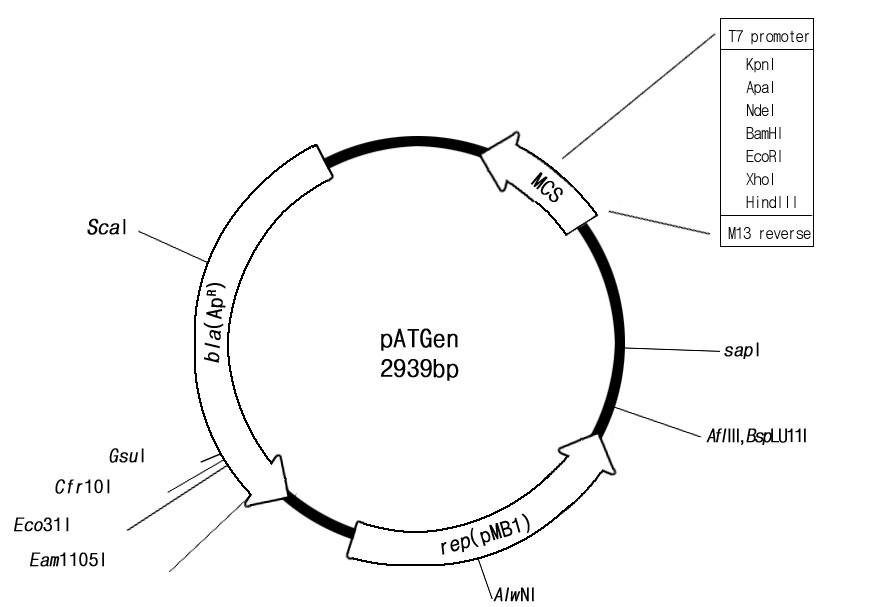Product Information
- Product Type
- cDNA
- Antigen Species
- Human
- NCBI Accession No.
- NP_006389.2
- Alternative names
- Ubiquitin D, Diubiquitin, FAT10, GABBR1, UBD-3
- RNA Reference Number
- NM_006398.3
- OMIM Number
- 606050
- Chromosome Location
- 6p21.3
Product Specification
- Formulation
- Lyophilized
- Storage
- Store the plasmid at -20C.
- cDNA size
- 498bp
- Preparation before usage
- 1. Centrifuge at 7000rpm for 1 minute.
2. Carefully open the vial and add 100ul of sterile water to dissolve the DNA.
Each tube contains approximately 10ug of lyophilized plasmid.
- Vector description:
- This shuttle vector contains the complete ORF. It is inseted BamH I to Xho I. The gene insert contains multiple cloning sites which can be used to easily cut and transfer the gene and recombination site into your expression vector.
- General Description
- Ubiquitin-like protein modifier which can be covalently attached to target protein and subsequently leads to their degradation by the 26S proteasome, in a NUB1L-dependent manner. Probably functions as a survival factor. Conjugation ability activated by UBA6. Promotes the expression of the proteasome subunit beta type-9 (PSMB9/LMP2). Regulates TNF-alpha-induced and LPS-mediated activation of the central mediator of innate immunity NF-kappa-B by promoting TNF-alpha-mediated proteasomal degradation of ubiquitinated-I-kappa-B-alpha. Required for TNF-alpha-induced p65 nuclear translocation in renal tubular epithelial cells (RTECs). May be involved in dendritic cell (DC) maturation, the process by which immature dendritic cells differentiate into fully competent antigen-presenting cells that initiate T-cell responses. Mediates mitotic non-disjunction and chromosome instability, in long-term in vitro culture and cancers, by abbreviating mitotic phase and impairing the kinetochore localization of MAD2L1 during the prometaphase stage of the cell cycle. May be involved in the formation of aggresomes when proteasome is saturated or impaired. Mediates apoptosis in a caspase-dependent manner, especially in renal epithelium and tubular cells during renal diseases such as polycystic kidney disease and Human immunodeficiency virus (HIV) -associated nephropathy (HIVAN).
Data
- Nucleotide Sequence:
ATGGCTCCCAATGCTTCCTGCCTCTGTGTGCATGTCCGTTCCGAGGAATGGGATTTAATGACCTTTGATGCCAACCCATATGACAGCGTGAAAAAAATCAAAGAACATGTCCGGTCTAAGACCAAGGTTCCTGTGCAGGACCAGGTTCTTTTGCTGGGCTCCAAGATCTTAAAGCCACGGAGAAGCCTCTCATCTTATGGCATTGACAAAGAGAAGACCATCCACCTTACCCTGAAAGTGGTGAAGCCCAGTGATGAGGAGCTGCCCTTGTTTCTTGTGGAGTCAGGTGATGAGGCAAAGAGGCACCTCCTCCAGGTGCGAAGGTCCAGCTCAGTGGCACAAGTGAAAGCAATGATCGAGACTAAGACGGGTATAATCCCTGAGACCCAGATTGTGACTTGCAATGGAAAGAGACTGGAAGATGGGAAGATGATGGCAGATTACGGCATCAGAAAGGGCAACTTACTCTTCCTGGCATGTTATTGTATTGGAGGGTGA - Translation Sequence:
MAPNASCLCV HVRSEEWDLM TFDANPYDSV KKIKEHVRSK TKVPVQDQVL LLGSKILKPR RSLSSYGIDK EKTIHLTLKV VKPSDEELPL FLVESGDEAK RHLLQVRRSS SVAQVKAMIE TKTGIIPETQ IVTCNGKRLE DGKMMADYGI RKGNLLFLAC YCIGG
Note: For research use only. This product is not intended or approved for human, diagnostics or veterinary use.
